 The Valley of the Upper Asón is internationally known by the quality of its caves. This is a part of Cantabria where we can find some of the largest underground systems in the region. There are around catalogued caves, this area being the most valuable in Cantabria and on of the most important in Spain. The mayority of archaelogical sites and caves are concentrated in three sectors: the Asón river margins and its tributary´s valleys, the Gándara river and its tributary the Carranza river.
The Valley of the Upper Asón is internationally known by the quality of its caves. This is a part of Cantabria where we can find some of the largest underground systems in the region. There are around catalogued caves, this area being the most valuable in Cantabria and on of the most important in Spain. The mayority of archaelogical sites and caves are concentrated in three sectors: the Asón river margins and its tributary´s valleys, the Gándara river and its tributary the Carranza river.
In Rasines we find the Cueva del Valle, shaped by the Silencio river for thousands of years. It is formed by a large entrance, with galleries and capricious formations along the 61 km of speleological itinerary. This is the longest cavity in the region and the second in Spain.

Close to the town of Ramales de la Victoria we will see the Cullalvera Cave, situated at the foot of the Mount Pando, of easy access. This cave is provided by footbridges that ease the access for disabled people.
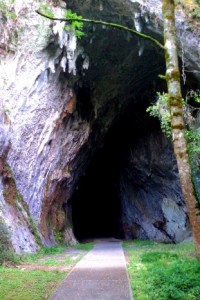
It is a very large cave, its access measures 40 mts of height and 30 mts of width. Ther is a strong and fresh breeze coming from inside.
Although there are paintings inside, they are not accessible, as they are situated at 600 – 1200 mts of depth. On rainny days the river flows from inside the cave and under the footbridge installed for easy access.
In the Modern Age, the cavity was used as a vehicle fleet during the Spanish Civil War.
The Covalanas cave was declared Patrimony of Humanity and it is commonly known as the cave of the red deers. It is situated on the northeast of the Pando mountain side. It was discovered in 1903 by Lorenzo Sierra and Hermilio Alcalde del Río. It is a small cave with two galeries sharing a common exterior cove. One of the galeries, on the right, habors the paintings.
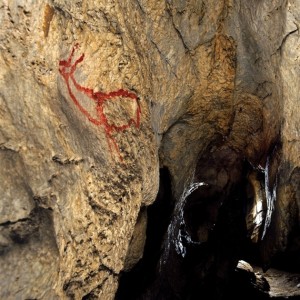 The first animal shaped figures appear 65 mts from the entrance. From this point onwadrs, the red figures appear on both sides of the cave walls. A total of eighteen female deers, one male deer, a horse, an aurochs, a possible hybrid and three rectangular signs, as well as small spots and lines on skateboards. 90 mts from the entrance of the cave the number of painting it is significally reduced. It dominates the dotted traces, made with fingers. This technical method is cahracteristic of some caves situated in the basin of the river Nervión (Vizcaya) and the river Sella (Asturias), being most concentrated around the river Asón. This distribution proofs the existence of human settlements with strong graphic links in different valleys, an example of social netting and contact. They are thought to date from 20.000 B.C.
The first animal shaped figures appear 65 mts from the entrance. From this point onwadrs, the red figures appear on both sides of the cave walls. A total of eighteen female deers, one male deer, a horse, an aurochs, a possible hybrid and three rectangular signs, as well as small spots and lines on skateboards. 90 mts from the entrance of the cave the number of painting it is significally reduced. It dominates the dotted traces, made with fingers. This technical method is cahracteristic of some caves situated in the basin of the river Nervión (Vizcaya) and the river Sella (Asturias), being most concentrated around the river Asón. This distribution proofs the existence of human settlements with strong graphic links in different valleys, an example of social netting and contact. They are thought to date from 20.000 B.C.
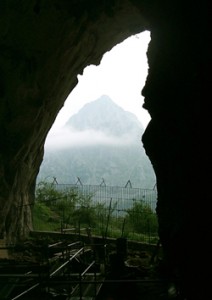
The Mirón cave is situated in a spectacular place, the Sierra de Hornijo and the Mountains of los La Busta and El Moro, surrounding the Mount Pando. In it, a large mouth opens up. Various engravings from the paleolithic period have been found here: different signs, a horse and a possible buffalo.
The cave houses an archaeological site with findings from the medieval times to the Middle and Upper Paleolithic, 40.000 years ago; currently the site is undergoing excavations and they normally happen in summer, which allows teh visitor to see the development of this type of investigations.
El Haza cave (Ramales de la Victoria)
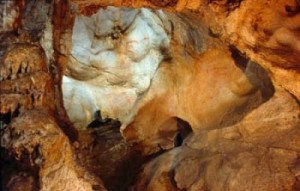 Close to the Covalanas cave we can find the La Haza, cavity declated Value of Cultural Interest in 1997. Discovered by H. Alcalde del Río and L. Sierra, in 1911, it is shaped by a wide cove in which there is a small space where cave paintings can be found.
Close to the Covalanas cave we can find the La Haza, cavity declated Value of Cultural Interest in 1997. Discovered by H. Alcalde del Río and L. Sierra, in 1911, it is shaped by a wide cove in which there is a small space where cave paintings can be found.
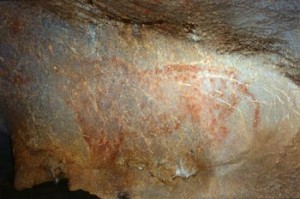 It shows an interesting group of red paintings of animals and signs. Various horses, a reindeer, a female deer and a four-footed animal. In addition, there are two signs quadrangular lines.
It shows an interesting group of red paintings of animals and signs. Various horses, a reindeer, a female deer and a four-footed animal. In addition, there are two signs quadrangular lines.
Peña Del Perro cove (Santoña)
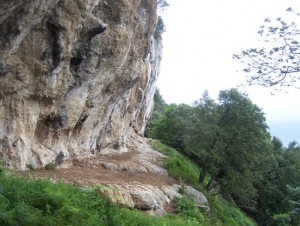 Cove of big dimensions, declared Valueo fo Cultural Interest 1998. Situated in a cliff area of the Mount Buciero to which we access from the Santoña forts, through a mountain path.
Cove of big dimensions, declared Valueo fo Cultural Interest 1998. Situated in a cliff area of the Mount Buciero to which we access from the Santoña forts, through a mountain path.
Discovered in the 80s. Descubierto en los años 80 del pasado siglo. Posteriormente, fue objeto de excavación arqueológica por parte de la Universidad de Cantabria. En el suelo aparecieron gran número de piezas líticas y restos óseos. Las excavaciones que en el mismo se realizaron proporcionaron niveles del Magdaleniense Superior y del Aziliense, este último con arpones planos, conservándose un gran conchero.
Contiene ocupaciones de hábitat del Paleolítico Superior final (Magdaleniense Superior final y Aziliense). Las manifestaciones rupestres, poco diagnósticas cronológicamente, pudieran ser muy anteriores (¿Auriñaciense-Gravetiense?), a partir de su comparación estilística.
Cueva Cobrante San Miguel de Aras (Voto)
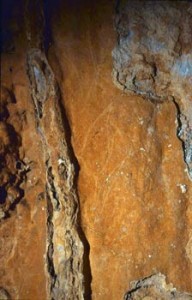 Cavidad situada en plena ladera del monte ubicado al sur del barrio de Caburrao. Descubierta por M. Sanz de Sautuola a finales del siglo pasado y declarada Bien de Interés Cultural en 1985
Cavidad situada en plena ladera del monte ubicado al sur del barrio de Caburrao. Descubierta por M. Sanz de Sautuola a finales del siglo pasado y declarada Bien de Interés Cultural en 1985
La cavidad alberga un gran yacimiento arqueológico con ocupaciones de todo el Paleolítico Superior. Las manifestaciones rupestres han sido asignadas al Magdaleniense.
Cavidad de grandes proporciones con un desarrollo de 500 m. Posee una gran boca que da acceso a un enorme vestíbulo. En la zona interior posee abundantes coladas y columnas.
Cueva Otero (Secadura)
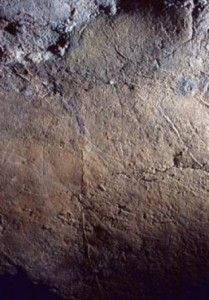 Fue descubierta en 1.909 por L. Sierra y declarada Bien de Interés Cultural en 1998. En el año 1.963 se realizaron excavaciones que llevó al reconocimiento de hasta nueve niveles estratigráficos que evidencian períodos Auriñacienses, Magdalenienses y Azilienses.
Fue descubierta en 1.909 por L. Sierra y declarada Bien de Interés Cultural en 1998. En el año 1.963 se realizaron excavaciones que llevó al reconocimiento de hasta nueve niveles estratigráficos que evidencian períodos Auriñacienses, Magdalenienses y Azilienses.
Cavidad de pequeño tamaño con dos bocas casi contiguas que dan acceso a un vestíbulo amplio que continua hacia la derecha por una galería recta que acaba en una salita.
A pesar de ser una cueva estudiada desde principios de siglo, no fue hasta el 1983 cuando se descubrió en sus paredes un grabado que representa la cabeza de un cáprido en visión frontal y un grupo de trazos no figurativos. La representación de animales en visión frontal es poco frecuente en el arte rupestre cantábrico. Dadas sus características parece pertenecer al período Magdaleniense SuperiorFinal, (unos 12.000 años de antigüedad).
El Valle de Liendo es debido a la peculiar morfología kárstica un referente importante a la hora de hablar de nuestros orígenes. En él podemos encontrar de manera fácilmente visible numerosos procesos geológicos.
En el Valle de Liendo debido a su peculiar morfología kárstica existen un gran número de cuevas, siendo las cuevas del Hoyo o de Yesta y la del Covacho o de Iseca Nueva, dos cuevas de gran desarrollo. Hasta la fecha están catalogadas unas veinte cuevas o abrigos, como la cueva de Haza Redonda, La cueva de Laza, cueva Negra, Cuevas de la Cruz I,II,III donde fueron realizados hallazgos de diferente importancia.
Los hallazgos realizados, desde el punto de vista arqueológico, pueden resultar extraordinarios, ya que se han encontrado restos de fauna que demuestran su existencia en otros periodos de la antigüedad, demostrando también que el valle de Liendo estuvo cubierto de grandes y espesos bosques que les servían de alimento, como en la cueva de Pinto donde se han descubierto a parte de otros restos, dos colmillos de oso de las cavernas.
En la cueva de los Tornillos se encontraron algunos sílex, restos de fauna así como algunos fragmentos cerámicos, en la cueva de las Lapas enclavada en el Alto de Candina se han hallado restos de mandíbula humana y fragmentos cerámicos atribuido al Bronce Antiguo. En la cueva Serán o de los Abalorios se encontraron restos del periodo Neolítico y la Edad del hierro.
Enlaces de interés :




